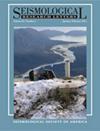Calibration of the Local Magnitude Scale (ML) for Eastern Cuba
IF 3.2
3区 地球科学
Q2 GEOCHEMISTRY & GEOPHYSICS
引用次数: 0
Abstract
Calibration of the local magnitude scale to match local tectonics is a key element in the development of research leading to seismic risk assessment and quantification of seismicity in active regions. In this study, we developed a local magnitude scale for the southeastern region of Cuba—the part of the island exposed to the greatest seismic hazard due to its proximity to the Oriente fault system. From the 2011–2021 Cuban catalog, 7750 earthquakes with ML>2 were selected, distributed in the region 19°–22° N, 73°–79° W, and recorded by at least four seismic stations (of the Cuban CW network) within 500 km of the hypocentre. The resulting input data set includes 33,916 amplitude measurements of the horizontal components. We set up the whole linear regression analysis procedure in the Matlab environment to obtain the formula for the local magnitude in the International Association of Seismology and Physics of the Earth’s Interior form. In a three-step procedure, we (1) removed the outliers; (2) searched for the parameters n, K, and Si that minimize the unbiased sample standard deviation of the residuals; and (3) set the anchor point for the parameter C. Thus, the new formula for the local magnitude ML is defined as follows: ML=log10(A)+1.000log10(R)+0.003R−1.963, in which A is the peak amplitude in nanometers simulated with a Wood–Anderson sensor, and R is the hypocentral distance in kilometers. We also calculated the station correction factors S for each station included in the analysis.校准古巴东部的地方震级表 (ML)
校准当地震级表,使其与当地构造相匹配,是开展地震风险评估和活跃地区地震量化研究的关键因素。在这项研究中,我们为古巴东南部地区制定了地方震级表--该地区因靠近 Oriente 断层系统而面临最大的地震风险。从 2011-2021 年古巴地震目录中选取了 7750 次震级大于 2 级的地震,这些地震分布在北纬 19°-22°、西经 73°-79°地区,并由距震中 500 公里范围内至少四个地震台(古巴 CW 网络)记录。由此得到的输入数据集包括 33,916 个水平分量的振幅测量值。我们在 Matlab 环境中设置了整个线性回归分析程序,以获得国际地震学和地球内部物理学协会表格中的当地震级公式。在三步程序中,我们:(1)剔除异常值;(2)寻找使残差的无偏样本标准偏差最小的参数 n、K 和 Si;(3)设置参数 C 的锚点:ML=log10(A)+1.000log10(R)+0.003R-1.963,其中 A 是用伍德-安德森传感器模拟的以纳米为单位的峰值振幅,R 是以公里为单位的次中心距离。我们还计算了分析中每个台站的台站校正因子 S。
本文章由计算机程序翻译,如有差异,请以英文原文为准。
求助全文
约1分钟内获得全文
求助全文
来源期刊

Seismological Research Letters
地学-地球化学与地球物理
CiteScore
6.60
自引率
12.10%
发文量
239
审稿时长
3 months
期刊介绍:
Information not localized
 求助内容:
求助内容: 应助结果提醒方式:
应助结果提醒方式:


